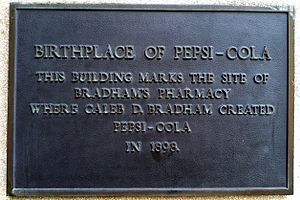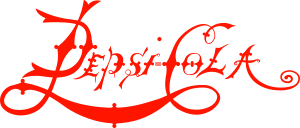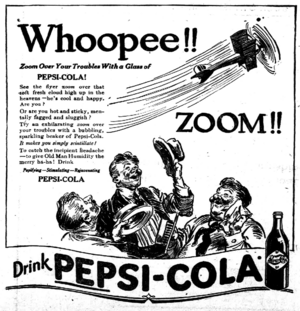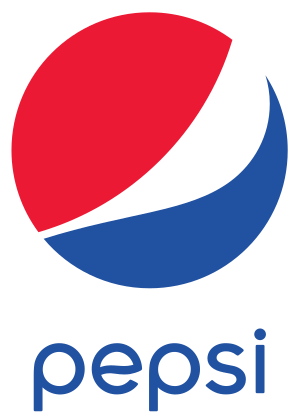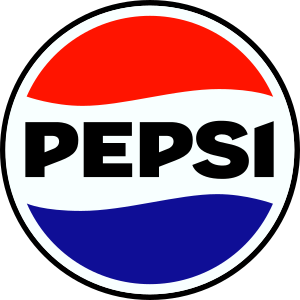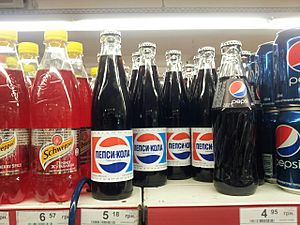Pepsi facts for kids
 |
|
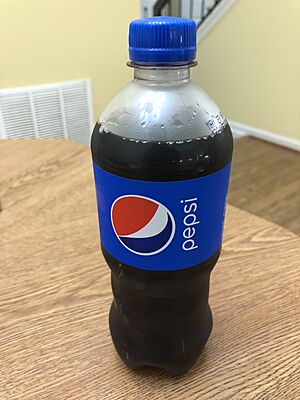
A bottle of Pepsi with the 2008–2023 logo
|
|
| Type | Cola |
|---|---|
| Manufacturer | PepsiCo |
| Country of origin | United States |
| Region of origin | New Bern, North Carolina |
| Introduced | 1893 (as Brad's Drink) 1898 (as Pepsi-Cola) 1961 (as Pepsi) |
| Color | Caramel E-150d |
| Variants | Diet Pepsi Pepsi Twist Pepsi Lime Pepsi Wild Cherry Crystal Pepsi Caffeine-Free Pepsi Pepsi-Cola Made with Real Sugar Pepsi Vanilla Pepsi Zero Sugar Pepsi Max Nitro Pepsi |
| Related products | |
Pepsi is a popular fizzy soft drink with a cola flavor. It is made by the company PepsiCo, and it is their most famous product. Pepsi has been a big rival to Coca-Cola for a long time. Their competition is often called the "cola wars".
Pepsi was first created in 1893 by Caleb Bradham. He called it "Brad's Drink" and sold it in his drugstore in New Bern, North Carolina. In 1898, it was renamed Pepsi-Cola because people thought it helped with digestion. The name was shortened to Pepsi in 1961. The original recipe included sugar and vanilla.
Pepsi faced money problems early on and went bankrupt in 1923. Later, Charles Guth bought the company and changed the recipe. Pepsi became more popular during the Great Depression when it started selling a larger 12-ounce bottle. A clever jingle, "Nickel, Nickel", helped double sales by showing customers they got more drink for their money.
In the mid-1900s, Pepsi started advertising to the African American community. This was a group that other companies often ignored. Pepsi used positive ads and got famous people to support their drink. This helped Pepsi gain more customers. Pepsi has stayed a major global brand through smart marketing and sponsoring sports and entertainment events.
Contents
The Story of Pepsi
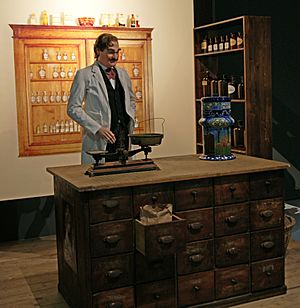
Pepsi was first made in 1893 by Caleb Bradham. He sold the drink, then called "Brad's Drink," at his pharmacy in New Bern, North Carolina.
In 1898, it was renamed Pepsi-Cola. The "Pepsi" part came from the idea that it helped with dyspepsia (indigestion). "Cola" referred to its cola flavor. Some people thought the name came from the digestive enzyme pepsin, but pepsin was never an ingredient in Pepsi-Cola.
The first recipe included sugar and vanilla. Bradham wanted to create a tasty fountain drink that also helped with digestion and gave people energy.
In 1903, Bradham moved the bottling of Pepsi from his drugstore to a larger warehouse. That year, he sold nearly 8,000 gallons of syrup. The next year, Pepsi was sold in small six-ounce bottles, and sales grew even more. In 1909, Barney Oldfield, a famous race car driver, was the first celebrity to promote Pepsi. He called it "A bully drink...refreshing, invigorating, a fine bracer before a race." For the next 20 years, Pepsi used the slogan "Delicious and Healthful."
In 1923, the Pepsi-Cola Company went bankrupt. This was mainly because of money lost from guessing wrong about sugar prices after World War I. The company's assets were sold, and Roy C. Megargel bought the Pepsi name. He couldn't find enough money to restart the brand. Later, Charles Guth, who ran a candy company called Loft, Inc., bought Pepsi-Cola's assets. He wanted to replace Coca-Cola at his stores' soda fountains because Coca-Cola wouldn't give him better discounts. Guth then had his chemists create a new Pepsi-Cola syrup recipe.
Between 1922 and 1933, The Coca-Cola Company had three chances to buy Pepsi-Cola. Each time, they said no.
How Pepsi Grew Popular
During the Great Depression, Pepsi became very popular. This happened after it started selling a larger 12-ounce (355 mL) bottle in 1934. Before that, both Pepsi and Coca-Cola sold their drinks in smaller 6.5-ounce (192 mL) bottles for about five cents.
Pepsi launched a radio ad campaign with a famous jingle called "Nickel, Nickel." The Tune Twisters first recorded it in 1940. The jingle encouraged people to buy Pepsi because they got twice as much drink for the same five cents. The jingle went: "Pepsi-Cola hits the spot / Twelve full ounces, that's a lot / Twice as much for a nickel, too / Pepsi-Cola is the drink for you."
This campaign was a big success during a tough economic time. From 1936 to 1938, Pepsi-Cola's profits doubled.
Pepsi's Marketing Over Time
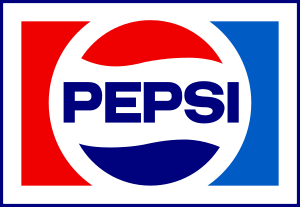
From the 1930s to the late 1950s, "Pepsi-Cola Hits The Spot" was a very common slogan. It was heard on radio, in movies, and on early television. The jingle was used in many ways with different words. Actress Polly Bergen helped promote Pepsi, often singing the classic jingle.
Film star Joan Crawford became a spokesperson for Pepsi after marrying its president, Alfred N. Steele. She appeared in commercials and TV shows for the company. After Steele passed away in 1959, Crawford joined Pepsi-Cola's Board of Directors.
Pepsi has appeared in many movies, including Back to the Future Part II (1989), Home Alone (1990), Wayne's World (1992), Fight Club (1999), and World War Z (2013).
Some Pepsi marketing campaigns have faced problems. In 1989, Pepsi planned a big campaign with Madonna's song "Like a Prayer". But it was canceled because of strong reactions to the song's music video. In 1992, the Pepsi Number Fever campaign in the Philippines accidentally gave out 800,000 winning bottle caps for a huge prize. This led to riots and five deaths.
In 1996, PepsiCo launched the very successful Pepsi Stuff program. This allowed customers to collect points from Pepsi products and trade them for merchandise. In 1997, Pepsi introduced a new design called "Project Blue." This included painting a Concorde airplane blue and putting a banner on the Mir space station. This new design became known as the Pepsi Globe.
In 2008, Pepsi announced it would change its logo and rebrand many products. By 2009, Pepsi, Diet Pepsi, and Pepsi Max started using all lowercase letters for their names. The blue and red globe logo began to look like a series of "smiles." In March 2023, Pepsi showed off a new logo. It is a modern version of an older Pepsi logo. The new branding also uses black as a main color instead of blue.
Targeting New Customers
Walter Mack became the new president of Pepsi-Cola in the 1940s. He noticed that Pepsi's ads usually ignored African Americans or used old stereotypes. At that time, many companies did not try to sell to Black customers.
Mack realized that Black people were an important group of customers that Pepsi could reach. He hired Hennan Smith, an advertising expert, to lead an all-Black sales team. This team had to stop working during World War II.
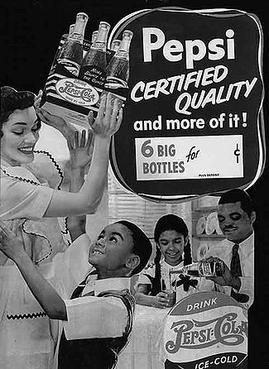
In 1947, Walter Mack started his efforts again. He hired Edward F. Boyd to lead a team of twelve men. They created ads that showed Black Americans in a positive way. One ad showed a smiling mother holding Pepsi, with her son (who grew up to be Secretary of Commerce Ron Brown) reaching for a bottle. Another campaign, "Leaders in Their Fields," featured famous African Americans like Nobel Peace Prize winner Ralph Bunche.
Boyd also led an all-Black sales team around the country to promote Pepsi. At that time, segregation was common in the U.S. Boyd's team faced a lot of unfair treatment. But they used Pepsi's anti-racism stance as a selling point. They pointed out that Coca-Cola was slow to hire Black people. As a result, Pepsi's sales among African Americans grew much faster than Coke's in the 1950s.
After Mack left the company in 1950, the Black sales team was eventually cut.
Boyd was replaced in 1952 by Harvey C. Russell Jr.. He created marketing campaigns for Black youth in New Orleans. These events encouraged children to collect Pepsi bottle caps. They could then trade the caps for prizes. For example, at a "Pepsi Day at the Beach" event in 1954, children could ride amusement park rides by trading Pepsi bottle caps.
Pepsi vs. Coca-Cola
In the 1970s, the competition between Pepsi and Coca-Cola grew stronger. Pepsi started doing blind taste tests in stores, called the "Pepsi Challenge". These tests showed that more people preferred the taste of Pepsi over Coca-Cola. Pepsi's sales began to rise, and the "Challenge" spread across the country. This period became known as the "cola wars."
In 1985, The Coca-Cola Company changed its formula. This new drink was called New Coke. Some believe it was made specifically to respond to the Pepsi Challenge. However, many customers did not like New Coke. So, Coca-Cola quickly brought back its original formula as "Coca-Cola Classic."
In 1989, Billy Joel sang about the rivalry in his song "We Didn't Start the Fire". The line "Rock & Roller Cola Wars" refers to how Pepsi and Coke used famous musicians in their ads. Coke used Paula Abdul, while Pepsi used Michael Jackson. Both companies then competed to get other musicians to advertise their drinks.
As of 2024, Pepsi is the third most popular soft drink in the United States. It is behind Coca-Cola and Dr Pepper. Coca-Cola generally sells more than Pepsi in most parts of the U.S. However, Pepsi sells more in places like central Appalachia, Montana, North Dakota, and Utah. In Buffalo, New York, Pepsi sells twice as much as Coca-Cola.
Globally, Coca-Cola usually outsells Pepsi. But there are exceptions, such as Oman, India, Saudi Arabia, Pakistan, the Dominican Republic, Guatemala, and the Canadian provinces of Quebec, Newfoundland and Labrador, Prince Edward Island, Nova Scotia, and New Brunswick.
Pepsi has long been popular with French-Canadians. It keeps its strong position by using local Québécois celebrities in its ads. PepsiCo created the Quebec slogan "here, it's Pepsi" (Ici, c'est Pepsi). This was a response to Coca-Cola's ads saying "Around the world, it's Coke" (Partout dans le monde, c'est Coke).
In India, Coca-Cola was the top soft drink until 1977. It left India because of new laws that required Indian companies to own most of the shares in businesses. Coca-Cola did not want to share its secret formula. In 1988, PepsiCo entered the Indian market. It formed a partnership with the government of Punjab. This partnership sold Lehar Pepsi until 1991, when foreign brands were allowed again. PepsiCo then bought out its partners. In 1993, Coca-Cola returned to India. As of 2012, Pepsi is the third most popular fizzy drink in India.
In Russia, Pepsi first had a larger market share than Coke. In 1972, PepsiCo made a deal with the government of the Soviet Union. PepsiCo could sell Stolichnaya vodka in Western countries. In return, Pepsi could be sold in the Soviet Union. This made Pepsi the first foreign product allowed for sale there. Pepsi became a symbol of Western products entering the Soviet system. After the Soviet Union broke up in 1991, Coca-Cola entered the Russian market in 1992. Coca-Cola quickly gained many customers because people saw it as a symbol of the new post-Soviet era.
Pepsi was introduced in Romania in 1966. A factory opened in Constanța in 1967. This was also a trade deal, with Romanian wine being sold in the West. Pepsi quickly became popular in Romania, especially among young people. But in the 1980s, it became hard to find due to strict economic rules. After the fall of Soviet communism in 1991, PepsiCo entered the new Romanian market. Pepsi still remains more popular than Coca-Cola in Romania.
Pepsi did not sell soft drinks in Israel until 1991. Many people thought Pepsi avoided Israel because of fears of an Arab boycott. Pepsi, which had a large business in the Arab world, said it was for economic reasons, not political ones.
Pepsiman, the Mascot
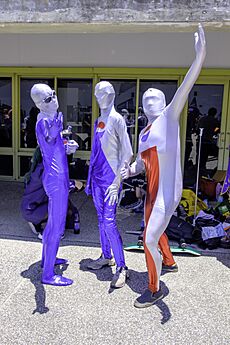
Pepsiman is an official Pepsi mascot from Pepsi's Japanese branch. He was created around the mid-1990s. Pepsiman had three different outfits, matching the design of the Pepsi can at the time. Twelve commercials were made featuring him. In the ads, he appears to thirsty people who want soda.
Pepsiman always shows up at the perfect moment with a Pepsi. After giving the drink, he sometimes gets into a tricky situation that causes him to get hurt. Pepsiman is mostly silent. He has no face, just a hole that opens when he gives out a Pepsi. There was also a minor mascot, Pepsiwoman, who appeared in ads for Pepsi Twist. She looked like a female Pepsiman wearing a lemon-shaped mask.
In 1994, Sega-AM2 released the Sega Saturn version of its fighting game Fighting Vipers. Pepsiman was a special character in this game. In 1999, KID made a video game for the PlayStation called Pepsiman. In the game, players control Pepsiman as he runs, skateboards, and rolls through areas. He avoids dangers and collects Pepsi cans, trying to reach a thirsty person. Even though the game was not a big financial success, Pepsiman has gained a cult following because of its silly and over-the-top idea.
Pepsi and Sports
Pepsi has official deals to sponsor the National Football League (NFL), National Hockey League (NHL), and National Basketball Association (NBA). From 2013 to 2022, Pepsi sponsored the NFL's Super Bowl halftime shows. It was also a sponsor for Major League Soccer until 2015 and Major League Baseball until 2017. Both of those leagues later signed deals with Coca-Cola. From 1999 to 2020, Pepsi also had the naming rights to the Pepsi Center, a sports and entertainment building in Denver, Colorado.
In 1997, after his deal with Coca-Cola ended, NASCAR driver Jeff Gordon signed a long-term contract with Pepsi. He drove with Pepsi logos on his car for about two races each year. Pepsi has been one of his sponsors ever since. Pepsi has also sponsored the NFL Rookie of the Year award since 2002.
Pepsi has global sponsorship deals with the UEFA Champions League and the UEFA Women's Champions League. These deals started in the 2015–16 season. Pepsi also sponsors international cricket teams. The Pakistani national cricket team wears the Pepsi logo on their uniforms.
The Buffalo Bisons, an American Hockey League team, were sponsored by Pepsi-Cola in their later years. The team used Pepsi's red, white, and blue colors and a changed Pepsi logo.
Pepsi has also sponsored the Carolina Hurricanes of the National Hockey League since the team moved to North Carolina in 1997. In 2017, Pepsi was the jersey sponsor for the Papua New Guinea national basketball team.
What's in Pepsi?
| Nutritional value per 12 fl oz (355 ml) | |
|---|---|
| Energy | 150 kcal (630 kJ) |
|
41
|
|
| Sugars | 41 |
| Dietary fiber | 0 |
|
0
|
|
| Saturated | 0 |
| Trans | 0 |
|
Protein
|
0
|
| Vitamins | Quantity
%DV†
|
| Vitamin A equiv. |
0%
0 μg |
| Vitamin C |
0%
0 mg |
| Minerals | Quantity
%DV†
|
| Calcium |
0%
0 mg |
| Iron |
0%
0 mg |
| Potassium |
0%
0 mg |
| Sodium |
1%
15 mg |
| Other constituents | Quantity |
| Cholesterol | 0 |
| †Percentages estimated using US recommendations for adults. | |
In the United States, Pepsi is made with carbonated water, high fructose corn syrup, caramel color, sugar, phosphoric acid, caffeine, citric acid, and natural flavors. A 12-ounce can of Pepsi has 41 carbohydrates (all from sugars), 30 mg of sodium, and 150 calories. It also has 38 mg of caffeine.
Pepsi has 10 more calories and two more grams of sugar and carbohydrates than Coca-Cola. Caffeine-Free Pepsi has the same ingredients but without the caffeine.
Some countries, like Sweden and the Netherlands, have recently reduced the sugar in regular Pepsi. They replaced it with artificial sweeteners like Acesulfame K and Sucralose. PepsiCo Europe made this change to cut the amount of sugar in their drinks. This new formula was also introduced in the United Kingdom in March 2023. There are no plans for this formula to be used in North America.
Different Kinds of Pepsi
Fictional Drinks
Pepsi Perfect: This was a special vitamin-enriched Pepsi shown in the movie Back to the Future Part II. It appeared in scenes set in the year 2015. Later, a limited number of these drinks were actually released. Only 6,500 bottles were available for $20.15. They have since been sold for hundreds of dollars online.
See also
 In Spanish: Pepsi para niños
In Spanish: Pepsi para niños
- List of Pepsi spokespersons
- Pepsi Max Big One (roller coaster)
- Pepsi Orange Streak (roller coaster)
- Pepsi Python (roller coaster)
- Mountain Dew
- Mountain Dew Amp
- Citrus Blast


